Have you ever wondered why your furry friend purrs when you pet her? Cats purr for a variety of reasons, and it’s not just to express contentment. Understanding their purring behavior can deepen the bond between you and your feline companion. Let’s explore the fascinating reasons behind why cats purr when being petted and unravel the mystery together.
Key Takeaways:
- Cats purr to communicate with their mother and seek warmth and nourishment as kittens.
- Purring is also a self-soothing mechanism for cats when they are nervous or in pain.
- The sound of purring comes from the muscles in a cat’s larynx.
- Purring can have healing properties, stimulating bone and tissue growth.
- Cats may purr when being petted to seek warmth, comfort, attention, and strengthen the bond with their owners.
The Communication Between Mother and Kittens
Purring is an instinctive behavior that starts from the moment a kitten is born. It serves as a mode of communication between mother cats and their offspring. When kittens are born, they are blind and deaf, making it difficult for them to locate their mother. Purring acts as a beacon, allowing the kittens to find their mother by following the sound vibrations.
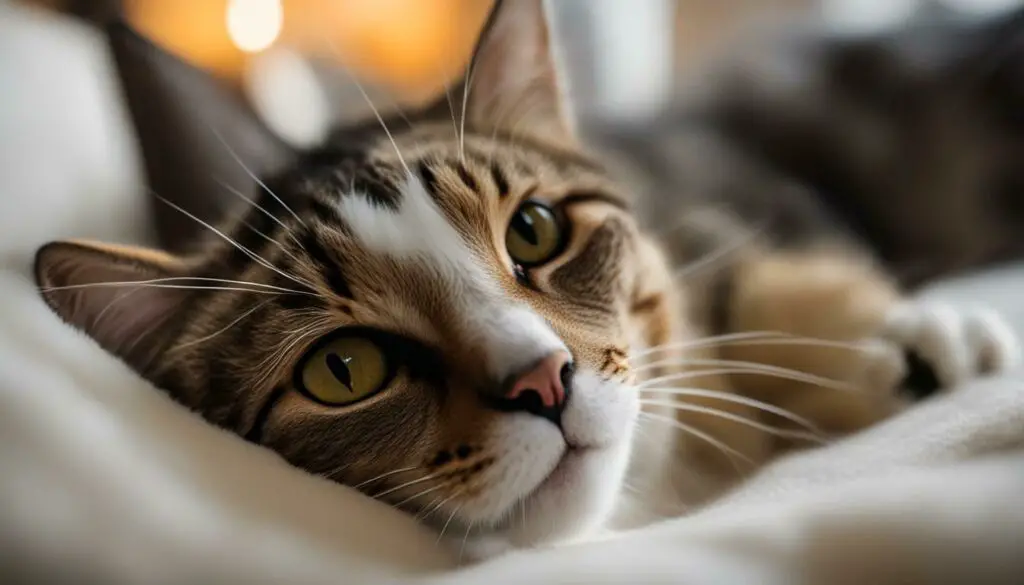
“Purring serves as a beacon, allowing kittens to find their mother by following the sound vibrations.”
Furthermore, purring also signals to the mother cat that her kittens are near, providing her with a sense of security and reassurance. It is a comforting sound that creates a bond between the mother and her offspring, fostering a strong relationship from the earliest stages of a kitten’s life.
The Language of Love
As kittens grow older, purring becomes a multifunctional form of communication. It not only helps them locate their mother but also serves as an expression of contentment, trust, and affection. By purring, kittens convey their well-being and acknowledge the positive interaction with their mother.
In summary, purring is a vital language for cats, allowing them to communicate with their mother and express their emotions. Understanding the significance of purring in their early days can help us better comprehend the complex nature of cat purring behavior.
| Key Points | Benefits |
|---|---|
| Purring helps kittens locate their mother. | Ensures warmth, nourishment, and security for the kittens. |
| Purring strengthens the bond between mother and kittens. | Creates a sense of comfort and reassurance for both parties. |
| Purring becomes a form of communication as kittens grow older. | Expresses contentment, trust, and affection. |
Purring as a Self-Soothing Mechanism
Purring is not always an expression of contentment; it can also act as a coping mechanism for cats. When cats feel nervous, in pain, or close to death, they may engage in purring to self-soothe and find comfort. This behavior allows them to regulate their emotions and create a sense of calmness within themselves.
Similar to how humans might seek solace in activities like deep breathing or listening to soothing music, cats turn to purring as a way to alleviate stress and anxiety. The rhythmic vibrations produced during purring have a soothing effect on their bodies and minds, helping them relax and find a sense of security.
“Purring is a self-healing mechanism for cats. It’s their way of finding comfort and coping with various emotional and physical challenges.” – Dr. Emily Johnson, Feline Behavior Specialist
Research suggests that the act of purring can have positive effects on a cat’s overall well-being. The vibrations created by purring are believed to stimulate the production of endorphins, natural painkillers, and improve blood circulation. Additionally, these vibrations may help stimulate bone and tissue growth, which can aid in the healing process for cats recovering from injuries or surgeries.

Understanding purring as a self-soothing mechanism can help cat owners better support their feline companions during times of stress or discomfort. Providing a calm and safe environment, offering gentle reassurance, and allowing the cat to engage in purring can contribute to their overall well-being and emotional recovery.
The Science Behind Purring
The mesmerizing sound of purring is a result of a complex muscular process within your cat’s throat. Purring is produced by the muscles in a cat’s larynx, also known as the voice box. When your cat purrs, the muscles in her larynx contract and relax rapidly, creating vibrations that resonate throughout her body and produce the familiar purring sound.
This muscular process is unique to cats and is not fully understood by scientists. However, it is believed that purring serves a variety of purposes beyond expressing contentment. The vibrations created during purring have been found to have healing properties, stimulating bone and tissue growth. It’s fascinating to think that your cat’s purring may not only be a sign of her happiness but also a way for her body to promote healing and well-being.
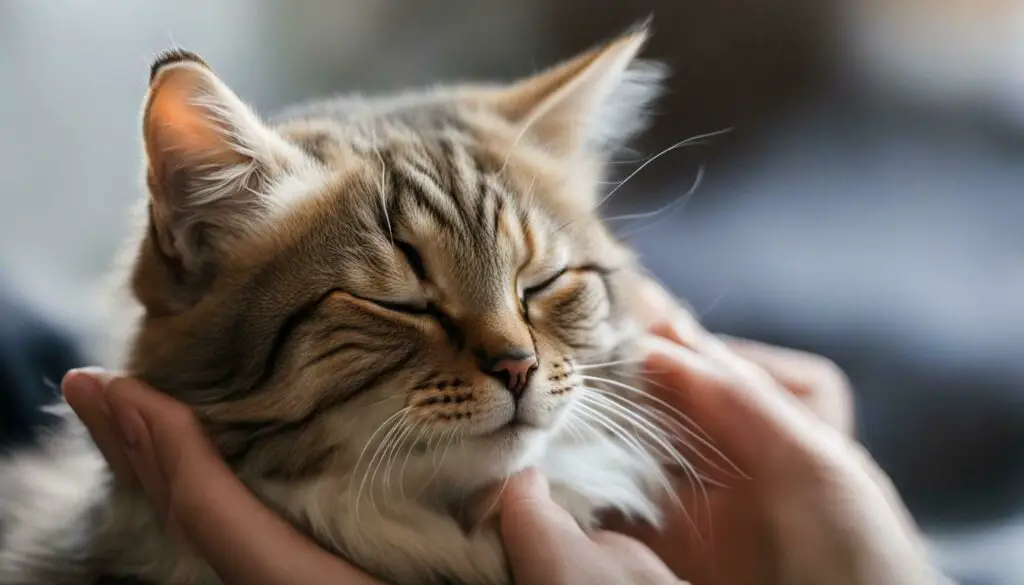
Decoding cat purring during petting can be a delightful task for cat owners. When you understand the different reasons behind your cat’s purring behavior, you can respond accordingly and nurture your bond with your feline companion.
The Healing Power of Purring
Research suggests that the vibrations produced by purring can have therapeutic benefits not just for cats but also for their owners. The rhythmic vibrations of purring have been shown to reduce stress, lower blood pressure, and promote relaxation in humans. So, the next time you feel overwhelmed, try spending some quality time petting your purring feline friend. You may just find yourself feeling calmer and more at ease.
| Benefits of Purring | For Cats | For Humans |
|---|---|---|
| Stress reduction | ✓ | ✓ |
| Promotes relaxation | ✓ | ✓ |
| Lower blood pressure | ✓ | ✓ |
| Stimulates bone and tissue growth | ✓ | – |
As a cat owner, it is important to recognize and appreciate the multifaceted nature of your cat’s purring behavior. By understanding the science behind purring and its various benefits, you can create a relaxing environment for your cat and strengthen the bond between you. So, next time your furry friend purrs while being petted, remember that it’s not just a sign of contentment but also a complex communication from your feline companion.
Seeking Warmth, Comfort, and Security
When your cat curls up on your chest and starts purring, it’s a sign that she feels safe and loved in your presence. Cats have long recognized the chest as a warm and comforting spot, and purring while nestled against you is their way of seeking warmth, comfort, and security. It’s a behavior that dates back to their days as kittens, when they would snuggle up to their mother for warmth and nourishment.
In the wild, cats seek out warm spots like sunlit patches or cozy nooks to curl up and rest. They instinctively recognize that being close to a warm body, such as their owner’s chest, can provide the same sense of security and comfort. By purring while being petted on the chest, your cat is essentially showing affection and trust, expressing gratitude for the loving environment you provide.
This behavior is not only beneficial for your cat but can also bring you joy and a sense of fulfillment. The rhythmic vibrations of the purring can have a soothing effect on your own well-being, promoting relaxation and reducing stress. It’s like a gentle massage that both you and your cat can enjoy, strengthening the bond between you.
So, next time your feline friend crawls onto your chest and starts purring, take a moment to cherish the connection you share. It’s a beautiful reminder of the warmth, comfort, and security that you provide for each other.

| Purring Behavior | Meaning |
|---|---|
| Relaxed purring | Contentment and trust |
| Slow, deep purring | Seeking comfort or attention |
| Fast, vibrating purring | Excitement or anticipation |
| Purring with kneading | Showing affection and happiness |
Attention and Bonding
Your cat’s purring when you pet her is a way for her to tell you that she enjoys your company and wants to connect with you. It’s a form of communication, an acknowledgment of the positive interaction between the two of you. Purring while being petted is a clear sign that your cat seeks attention and longs for a deeper bond with her human companion.
When your cat purrs, it’s an invitation for you to engage with her. It’s her way of saying, “I trust you, and I want to strengthen our relationship.” Paying attention to her purring and responding with love and care is crucial in nurturing a strong bond.
One way to deepen your connection is by creating a relaxing and stress-free environment for your cat. Cats thrive in peaceful spaces, and providing a calm atmosphere can encourage more purring and strengthen your bond. Whether it’s setting up a cozy corner with her favorite blanket or playing relaxing music, a serene environment will help her feel safe and loved.
| Benefits of Attention and Bonding |
|---|
| • Increased trust and affection |
| • Strengthened bond between you and your cat |
| • Enhanced overall well-being for your cat |
| • Promoted relaxation and stress reduction for both of you |
Your cat’s purring when you pet her is a unique invitation into her world. Embrace this opportunity to connect and create a space where both of you can thrive. By understanding the attention and bonding behind her purring behavior, you contribute to her happiness and cultivate a strong, loving relationship.
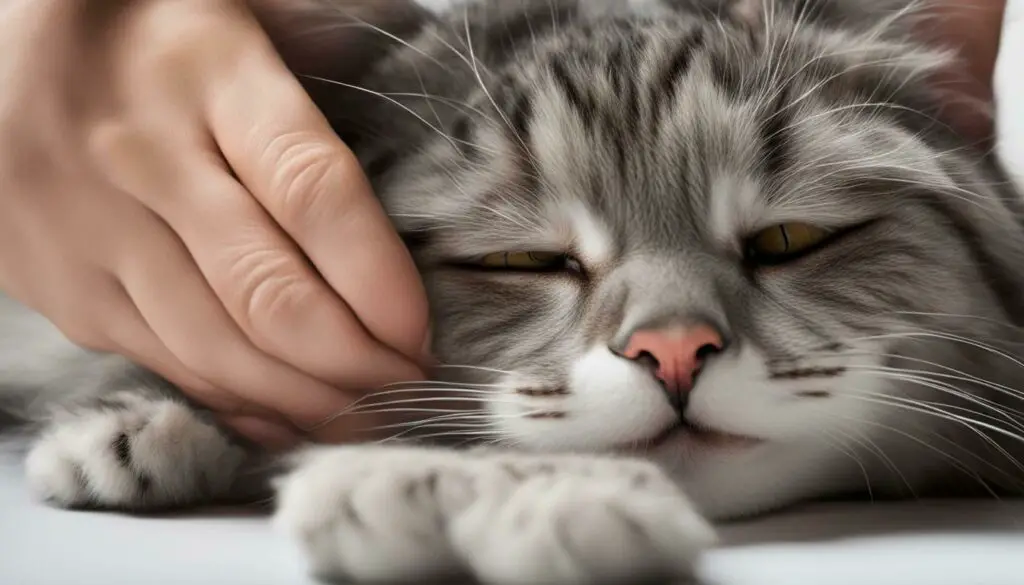
Therapeutic Benefits for Cats and Humans
The act of petting your cat and hearing her purr can create a calming atmosphere for both of you. The rhythmic vibrations of her purring can have a therapeutic effect, reducing stress and promoting relaxation. This is why many people find the presence of a purring cat to be soothing and comforting.
In fact, research has shown that the act of petting a cat can lower blood pressure and release calming endorphins in humans. It can also help reduce anxiety and improve overall emotional well-being. Cats, on the other hand, may experience a sense of comfort and security when being petted, which can contribute to their overall health and happiness.
According to experts, the healing properties of purring extend beyond the emotional benefits. The vibrations produced during purring have been found to stimulate bone and tissue growth. This can be especially beneficial for cats who are recovering from surgery or injury. The gentle vibrations can help reduce pain and aid in the healing process.
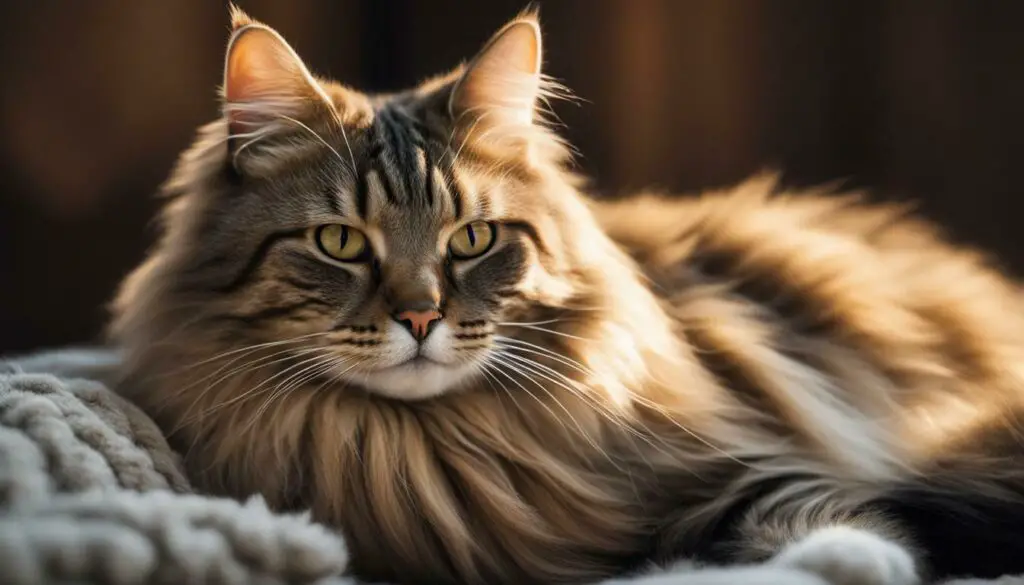
Creating a Relaxing Environment
To create a relaxing environment for your cat, consider providing her with a cozy and safe space where she can retreat when she needs some quiet time. This can be a designated area with a comfortable bed, toys, and a scratching post. Additionally, playing soft background music or using pheromone diffusers can help create a calming atmosphere.
Regular playtime and mental stimulation are also important for a cat’s well-being. Engage in interactive play sessions using toys that mimic natural prey behavior. This not only provides exercise but also helps relieve stress and keeps your cat mentally stimulated.
Remember, each cat is unique, so pay attention to her individual preferences and needs. By providing a calm and stress-free environment, you can enhance the therapeutic benefits of your cat’s purring and strengthen the bond between you.
Strengthening the Bond
By understanding the motivations behind your cat’s purring, you can deepen the connection you share with her. Purring is not just a sign of contentment; it serves as a powerful tool for communication and bonding. When your cat purrs while being petted, she is expressing affection, seeking attention, and solidifying the bond between you.
As you stroke your cat’s fur and hear the gentle rumble of her purring, you know that you are providing her with comfort and security. This shared moment of physical contact creates a sense of trust and reassurance. In return, your cat’s purring can have a profound impact on your well-being. The rhythmic vibrations produced by her purring act as a form of therapy, reducing stress and promoting relaxation for both of you.
Building a strong bond with your cat goes beyond mere petting. Take the time to observe her body language, listen to her vocalizations, and respond to her needs. By engaging in interactive play, providing a stimulating environment, and offering affectionate gestures, you can create a nurturing space where your cat feels loved and understood.
Remember, every cat is unique, and their purring behavior may vary. Pay attention to the different contexts in which your cat purrs and adapt your response accordingly. With patience, love, and a deeper understanding of cat purring behavior, you can foster a bond that will last a lifetime.
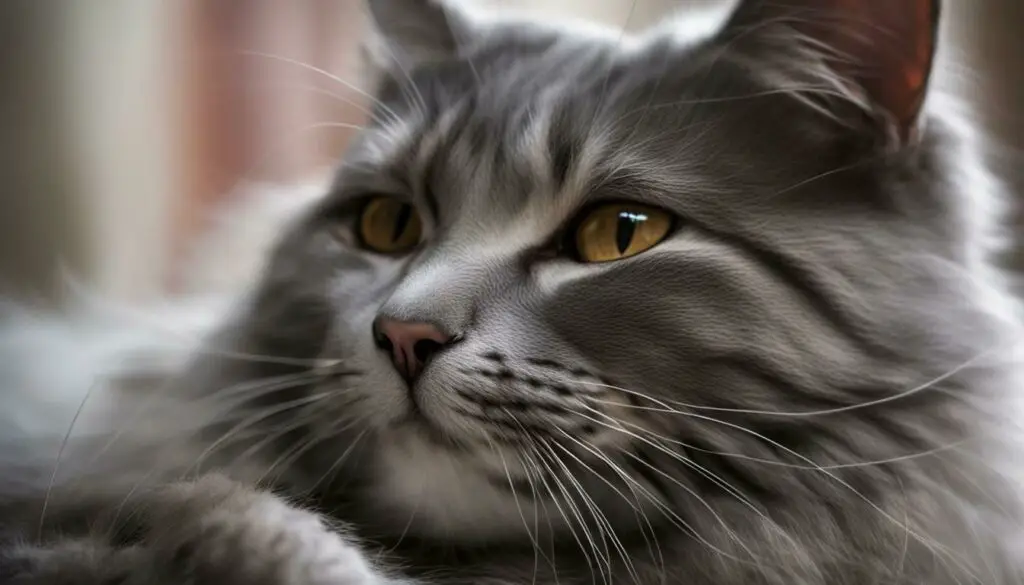
The Unique Language of Cats
Cats have a remarkable ability to communicate with us through their purrs and various other forms of expression. Purring, in particular, plays a significant role in their unique language. While many believe that cats purr simply to express contentment, the truth is that there are several reasons why cats purr when being petted.
One of the main reasons cats purr when petted is rooted in their early days as kittens. Purring is a way for kittens to communicate with their mother, signaling their presence and soliciting warmth and nourishment. This behavior becomes ingrained in them and persists into adulthood as a means of seeking comfort and security.
Purring is not limited to moments of pleasure; it can also serve as a self-soothing mechanism for cats. When they are nervous, in pain, or even close to death, purring can provide them with a sense of calm and alleviate their distress. In this way, purring becomes a coping mechanism and a way for cats to find solace during challenging times.
The science behind purring is equally fascinating. The sound of purring is produced by the muscles in a cat’s larynx, which cause vibrations that create the distinctive purring sound. These vibrations are not only audible but also have physical effects on the cat’s body. It is believed that the rhythmic vibrations of purring can stimulate bone and tissue growth, making purring a potential therapeutic tool for healing and recovery.
| Reasons for Cat Purring When Petted |
|---|
| Kittens use purring to communicate with their mother for warmth and nourishment. |
| Cats purr as a self-soothing mechanism in times of stress, pain, or distress. |
| Purring is produced by the muscles in a cat’s larynx and can have healing properties. |
| Cats may purr while being petted to seek warmth, comfort, security, attention, and bonding. |
Cats purr when being petted to communicate their needs and emotions. By deciphering their purring behavior, we can better understand and respond to their desires, ultimately strengthening the bond between cats and their human companions. So next time your cat purrs while being petted, remember that she is not only expressing contentment but also conveying a complex range of messages and seeking connection.
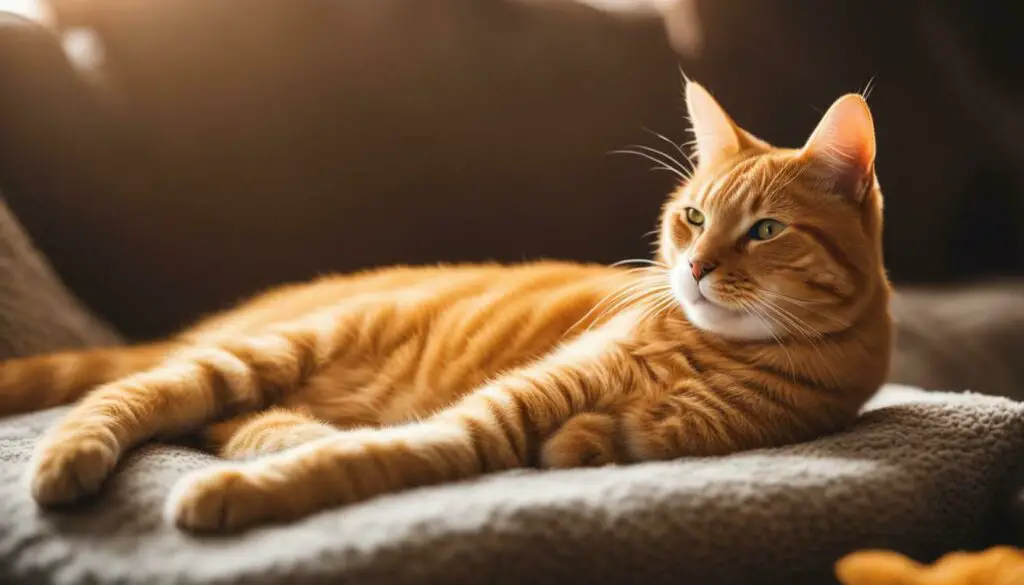
Nurturing a Healthy and Happy Cat
Meeting your cat’s emotional needs by responding to her purring can contribute to a healthier and happier feline companion. Purring is not just a sign of contentment in cats; it serves as a way for them to communicate and express their needs. Understanding the behavior behind cat purring can help you provide the right care and support for your furry friend.
When your cat purrs while being petted, it can indicate various things. For kittens, purring is a way to communicate with their mother, signaling their presence and seeking warmth and nourishment. This behavior stems from their early bonding experiences and dependency. So, when your adult cat purrs during petting, she may still be seeking the comfort and security reminiscent of her kitten days.
Furthermore, purring can also be a self-soothing mechanism for cats. It helps them calm themselves when they are nervous, in pain, or even close to death. The act of purring releases endorphins, which can provide them with a sense of relief and relaxation. By acknowledging and responding to your cat’s purring, you can create a safe and nurturing environment for her well-being.
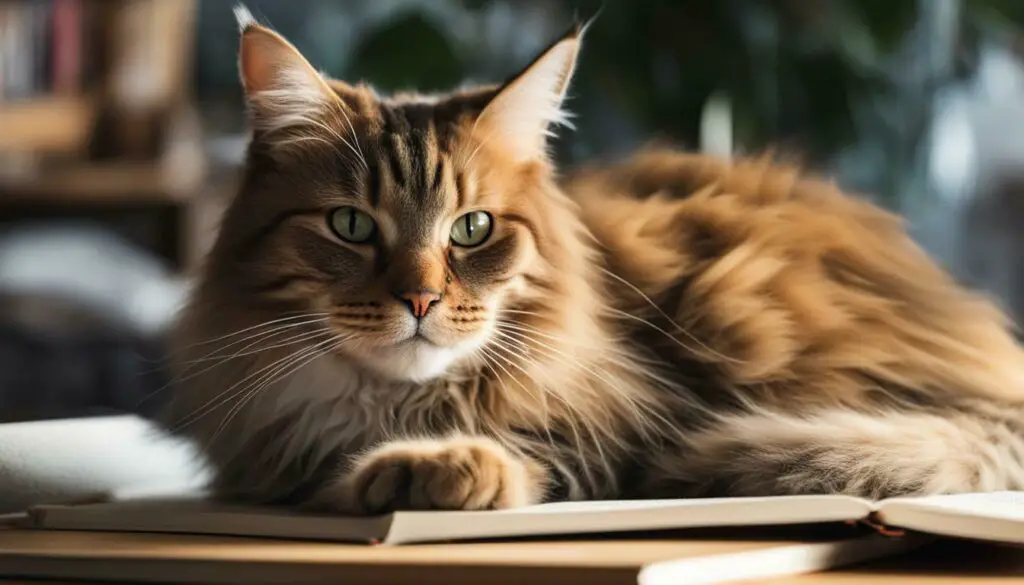
The science behind purring is fascinating. It is produced by the muscles in a cat’s larynx, creating vibrations that result in the familiar purring sound. These vibrations are not only audible but have healing properties as well. They can stimulate bone and tissue growth, making purring a unique and beneficial behavior for cats.
So, the next time your cat purrs when you pet her, take a moment to appreciate the intricate language of feline communication. By recognizing the different reasons behind her purring behavior, you can respond appropriately and nurture a stronger bond with your beloved cat.
Creating a Relaxing Environment
Providing a peaceful environment can encourage your cat to purr more often and enjoy her time with you. Cats are highly sensitive to their surroundings, and a calm and stress-free atmosphere can have a positive impact on their behavior and overall well-being. Here are some tips to help you create a relaxing environment for your feline friend:
- Designate a quiet space: Cats appreciate having their own designated area where they can retreat and relax. Set up a cozy corner with a comfortable bed, a few toys, and a scratching post. This will give your cat a sense of security and a space to call her own.
- Avoid loud noises: Loud noises can startle and stress out cats. Try to minimize loud television or music sounds, and avoid sudden loud noises around your cat’s sleeping or resting area.
- Provide hiding spots: Cats love to hide, especially when they feel the need to retreat or feel safe. Offer a variety of hiding spots, such as cardboard boxes, cat tunnels, or elevated shelves. These hiding spots can provide a sense of security and comfort for your cat.
Remember, each cat is unique, and what works for one may not work for another. Take the time to understand your cat’s preferences and adjust the environment accordingly. By creating a relaxing atmosphere, you can help your cat feel more at ease and increase the chances of her purring contentedly in your presence.
| Table Header 1 | Table Header 2 |
|---|---|
| Table Cell 1 | Table Cell 2 |
| Table Cell 3 | Table Cell 4 |
Creating a peaceful environment is crucial for cats to feel safe and secure. It allows them to relax and fully enjoy their time with you. Remember, a content and relaxed cat is more likely to purr and show affection towards her human companion.
By following these simple suggestions, you can create a serene and welcoming environment for your cat. Remember, understanding your cat’s needs and providing a tranquil atmosphere can go a long way in fostering a strong and loving bond between you and your feline friend.
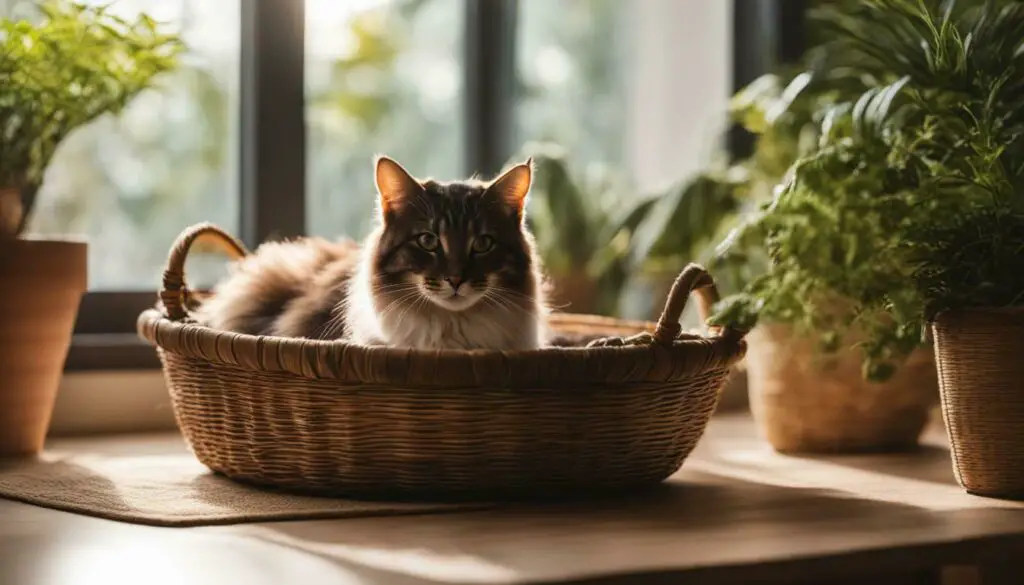
Summary:
Creating a peaceful environment for your cat is key to encouraging more purring and a stronger bond between you. Designating a quiet space, avoiding loud noises, and providing hiding spots are essential steps in creating a relaxing atmosphere. By following these tips and understanding your cat’s preferences, you can help your feline friend feel safe, secure, and content. In turn, your cat will be more likely to purr happily in your presence, enhancing the mutual enjoyment of your time together.
The Power of Purring
The gentle vibrations of a purring cat can have a profound impact on both your emotional and physical well-being. Cats purr for a variety of reasons, and understanding their behavior can enhance the bond between you and your feline companion. When a cat purrs while being petted, it signifies not only contentment but also communication, self-soothing, and seeking warmth and security.
As kittens, cats use purring to communicate with their mother, signaling their presence and seeking nourishment and warmth. This behavior carries into adulthood as a way to establish a strong bond with their human caregivers. Purring can also serve as a self-soothing mechanism for cats. When they are nervous, in pain, or even near death, purring provides them with comfort and calmness.
The science behind purring is fascinating. The muscles in a cat’s larynx produce the purring sound, which is created through vibrations. These vibrations are believed to have healing properties, stimulating bone and tissue growth. When you pet your cat and she purrs, it’s a sign of trust and affection. Cats may purr on your chest to seek warmth, comfort, and security, and to strengthen the bond between you.
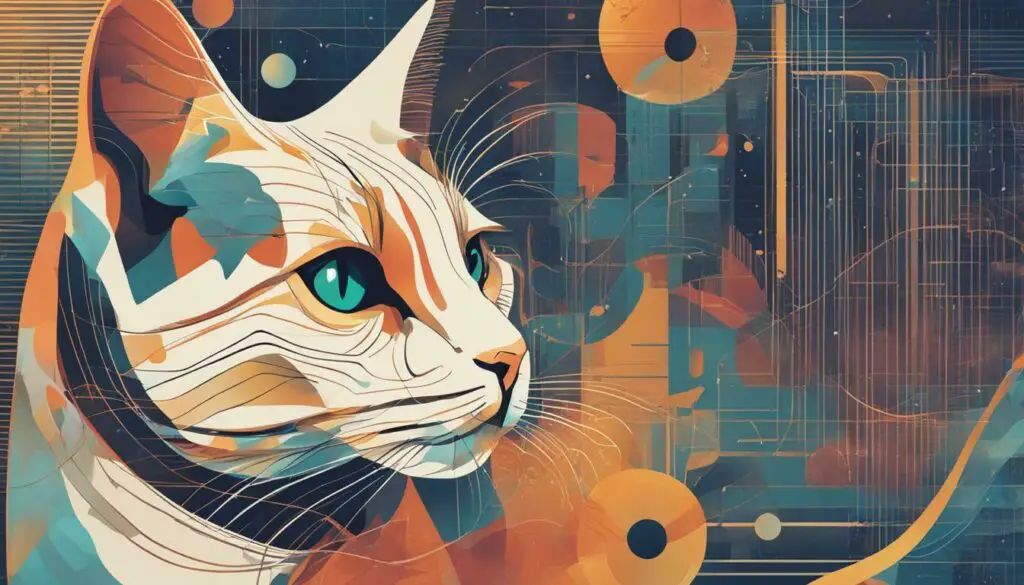
| Reasons for Cat Purring When Petted |
|---|
| Communication: Purring is a way for cats to communicate with their caregivers and establish a bond. |
| Self-Soothing: Cats purr to comfort themselves when they are nervous, in pain, or close to death. |
| Seeking Warmth and Security: Purring while being petted can be a cat’s way of seeking warmth, comfort, and a sense of security. |
| Attention and Bonding: Cats may purr to seek attention from their owners and strengthen the bond between them. |
The therapeutic benefits of cat purring extend not only to the feline but also to their human companions. The rhythmic vibrations of purring can reduce stress levels and promote relaxation for both cats and humans. Understanding why cats purr when being petted allows you to respond accordingly and nurture a healthy and happy relationship with your furry friend. So, the next time your cat purrs during a cuddle session, cherish the special connection you share.
Cultivating a Strong Bond
Building a strong bond with your cat involves appreciating and reciprocating her purring gestures. Purring is not just a sign of contentment; it is a multifaceted behavior that carries various meanings. Understanding why your cat purrs when being touched can deepen your connection and create a harmonious relationship.
One of the reasons cats purr when being petted is to seek warmth, comfort, and security. When your feline companion curls up on your chest and starts purring, she is basking in the cozy and safe environment you provide. This gesture shows her affection and trust in you, and reciprocating that by stroking her gently can strengthen your bond.
Purring also serves as a form of communication and attention-seeking behavior. Cats purr to establish a connection with their owners and express their desire for interaction. By acknowledging your cat’s purring and responding with love and affection, you foster a sense of belonging and create a positive association between you.
A Therapeutic Connection
Aside from the emotional aspects, the act of purring itself can have therapeutic benefits. The rhythmic vibrations produced by purring have been found to reduce stress and promote relaxation, not only for your cat, but also for you. It’s a symbiotic relationship where both parties can experience a sense of calm and well-being.
To strengthen your bond with your cat, create a relaxing environment that encourages purring. Provide cozy beds, soothing music, and a safe space where your cat can retreat and unwind. By prioritizing her comfort and emotional needs, you create a positive atmosphere that enhances your connection.
| Key Takeaways: |
|---|
|
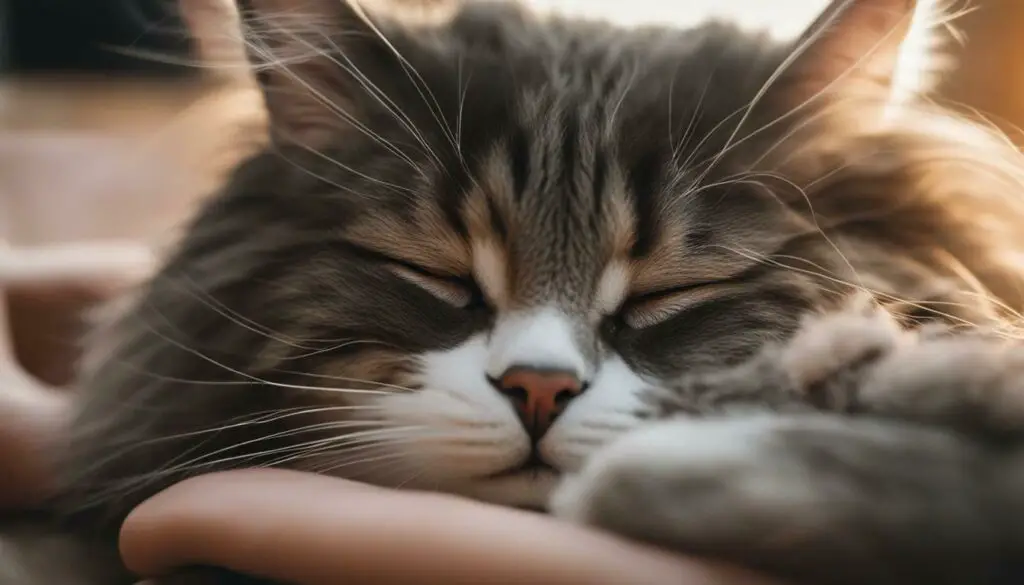
No matter the reason behind your cat’s purring, embracing and reciprocating this behavior is essential for cultivating a strong bond. By understanding and appreciating your cat’s purring gestures, you can create a loving and harmonious relationship that benefits both of you.
Understanding the Enigma of Cat Purring
The next time your cat purrs when you pet her, remember that it’s her unique way of sharing warmth, seeking comfort, and showing you affection. Cats have been purring since their early days as kittens, using this behavior as a means to communicate with their mother. Purring allows them to signal their presence, seeking warmth and nourishment. But purring doesn’t stop with kittenhood; it continues to serve a variety of purposes throughout a cat’s life.
When cats purr, it’s not always a sign of contentment. They also purr to self-soothe, providing themselves with comfort in times of stress, pain, or even during their final moments. The sound of purring originates from the muscles in a cat’s larynx, creating gentle vibrations that can have remarkable healing properties. These vibrations stimulate bone and tissue growth, contributing to the potential therapeutic benefits of purring.
So, why does your cat purr when you pet her? It could be that she seeks warmth, comfort, and security. Purring while being petted on your chest is a way for her to find solace in your presence. It’s her way of showing affection and trust, solidifying the bond between you and your feline companion. Additionally, purring serves as a form of communication, attracting attention and strengthening the connection between cats and humans.
Not only does purring benefit cats, but it also has positive effects on their owners. The rhythmic vibrations produced during purring can reduce stress and promote relaxation for both parties involved. By responding to your cat’s purring with love and care, you nurture a healthy and happy cat. Understanding the complexities of cat purring allows you to create a relaxed environment that encourages more purring and strengthens the bond between you and your furry friend.
FAQ
Why do cats purr when being petted?
Cats purr when being petted for a variety of reasons. It can be a sign of contentment, but they may also purr to seek warmth, comfort, security, attention, and bonding.
Why do kittens purr?
Kittens purr as a way to communicate with their mother, signaling their presence and seeking warmth and nourishment.
Do cats purr when they are in pain?
Yes, cats may purr when they are in pain. Purring can provide them with comfort and calmness as a self-soothing mechanism.
How do cats purr?
Purring is produced by the muscles in a cat’s larynx. The vibrations created during purring can have healing properties, stimulating bone and tissue growth.
Why do cats purr on their owner’s chest?
Cats may purr on their owner’s chest to seek warmth, comfort, and a sense of security. It’s their way of showing affection and trust towards their human companion.
What are the therapeutic benefits of cat purring?
Purring can have therapeutic benefits for both cats and humans. The rhythmic vibrations of purring can reduce stress and promote relaxation for both parties involved.
How can understanding cat purring behavior strengthen the bond between cats and their owners?
Understanding why cats purr when being petted allows owners to respond accordingly and nurture their relationship. Recognizing the different reasons behind their purring behavior helps strengthen the bond.
What other behaviors contribute to cat communication?
Purring during petting is just one aspect of the intricate language of cats. Exploring their vocalizations, body language, and other behaviors can further enhance your understanding of their needs and emotions.
How can responding to a cat’s purring contribute to their overall well-being?
By responding to your cat’s purring and providing the affection and attention she seeks, you contribute to her overall well-being. A happy and content cat is more likely to lead a fulfilling life.
How can I create a relaxing environment for my cat?
Cats thrive in environments that promote relaxation. By creating a calm and stress-free space for your cat, you can encourage more purring and strengthen the bond between you.
What is the power of purring?
Purring has healing properties that extend beyond the physical realm. It can provide emotional support and reinforce the connection between cats and humans.
How can I cultivate a strong bond with my cat?
When you respond to your cat’s purring with love and care, you foster a deep bond between you. The more you understand and appreciate your cat’s communication, the stronger your connection will become.
How can understanding cat purring deepen our relationship with them?
By decoding the enigma of cat purring, we can deepen our understanding and nurture our bond with these incredible creatures. Understanding their purring behavior enhances our ability to communicate and connect with them.
What role does purring play in the relationship between cats and their owners?
Purring serves multiple purposes in the relationship between cats and their owners. It helps cats communicate, seek comfort, and create a therapeutic environment, ultimately strengthening the bond between them.
Can cats purr for reasons other than contentment?
Yes, cats can purr for reasons other than contentment. They may also purr to self-soothe when they are nervous, in pain, or close to death.








